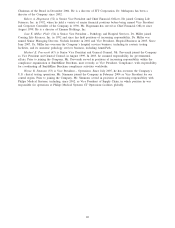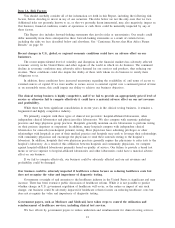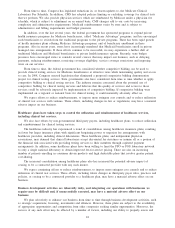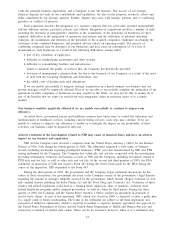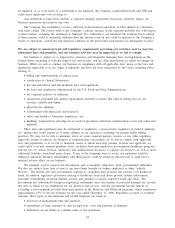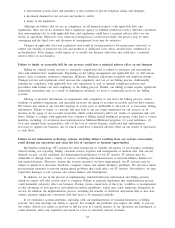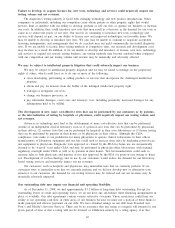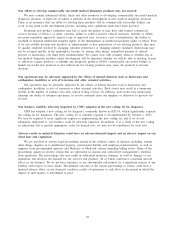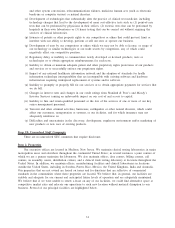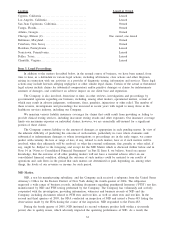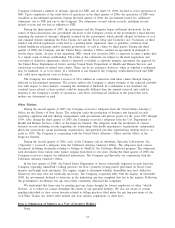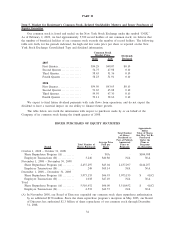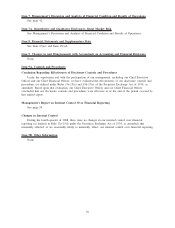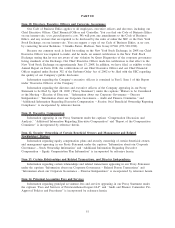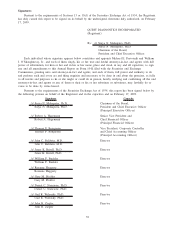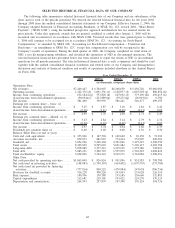Quest Diagnostics 2008 Annual Report Download - page 42
Download and view the complete annual report
Please find page 42 of the 2008 Quest Diagnostics annual report below. You can navigate through the pages in the report by either clicking on the pages listed below, or by using the keyword search tool below to find specific information within the annual report.CAUTIONARY FACTORS THAT MAY AFFECT FUTURE RESULTS
Some statements and disclosures in this document are forward-looking statements. Forward-looking
statements include all statements that do not relate solely to historical or current facts and can be identified by
the use of words such as “may”, “believe”, “will”, “expect”, “project”, “estimate”, “anticipate”, “plan” or
“continue.” These forward-looking statements are based on our current plans and expectations and are subject to
a number of risks and uncertainties that could cause our plans and expectations, including actual results, to differ
materially from the forward-looking statements. Investors are cautioned not to unduly rely on such forward-
looking statements when evaluating the information presented in this document. The following important factors
could cause our actual financial results to differ materially from those projected, forecasted or estimated by us in
forward-looking statements:
(a) Heightened competition from independent clinical testing companies, and from hospitals with respect to
testing for non-patients and from physicians.
(b) Increased pricing pressure from customers and payers.
(c) A sustained decline in economic conditions, or turmoil in financial markets leading to lack of access to
external capital over a sustained period of time or on reasonable terms.
(d) Impact of changes in payer mix, including any shift from fee-for-service to discounted or capitated fee
arrangements.
(e) Adverse actions by government or other third-party payers, including healthcare reform that focuses on
reducing healthcare costs but does not recognize the value and importance to healthcare of diagnostic
testing, unilateral reduction of fee schedules payable to us, competitive bidding, and an increase in the
practice of negotiating for exclusive arrangements that involve aggressively priced capitated or fee-for-
service payments by health insurers or other payers.
(f) The impact upon our testing volume and collected revenue or general or administrative expenses
resulting from our compliance with Medicare and Medicaid administrative policies and requirements of
third party payers. These include:
(1) the requirements of Medicare carriers to provide diagnosis codes for many commonly ordered tests
and the possibility that third party payers will increasingly adopt similar requirements;
(2) the policy of CMS to limit Medicare reimbursement for tests contained in automated chemistry
panels to the amount that would have been paid if only the covered tests, determined on the basis
of demonstrable “medical necessity,” had been ordered;
(3) continued inconsistent practices among the different local carriers administering Medicare;
(4) inability to obtain from patients a valid advance beneficiary notice form for tests that cannot be
billed without prior receipt of the form; and
(5) increased challenges in operating as a non-contracted provider with respect to health plans.
(g) Adverse results from pending or future government investigations, lawsuits or private actions. These
include, in particular, monetary damages, loss or suspension of licenses, and/or suspension or exclusion
from the Medicare and Medicaid programs and/or criminal penalties.
(h) Failure to efficiently integrate acquired businesses and to manage the costs related to any such
integration, or to retain key technical, professional or management personnel.
(i) Denial of CLIA certification or other licenses for any of our clinical laboratories under the CLIA
standards, revocation or suspension of the right to bill the Medicare and Medicaid programs or other
adverse regulatory actions by federal, state and local agencies.
(j) Changes in federal, state or local laws or regulations, including changes that result in new or increased
federal or state regulation of commercial clinical laboratories or tests developed by commercial clinical
laboratories, including regulation by the FDA.
(k) Inability to achieve expected benefits from our acquisitions of other businesses.
(l) Inability to achieve additional benefits from our Six Sigma and efficiency initiatives.
(m) Adverse publicity and news coverage about the clinical testing industry or us.
(n) Computer or other IT system failures that affect our ability to perform tests, report test results or
properly bill customers, including potential failures resulting from the standardization of our IT systems
30


